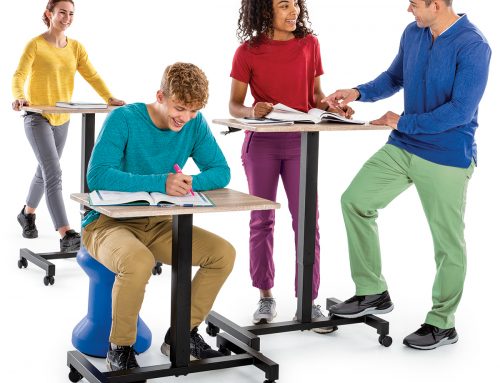
As humans, we were made to move! Unfortunately, schools are very sedentary places in which students are often rewarded for sitting still. This not only negatively affects their health, but it affects their behavior and learning.
Numerous studies have been conducted finding that any and all movement, benefits students at school. One simple way for teachers to allow movement without planning any breaks into their lesson is the inclusion of standing desks within the classroom. Standing desks are alternate types of workstations in which students may choose to position the desk at a level convenient for sitting or standing.
Standing Desk Study
We actually conducted a simple study in a middle school classroom in which the teacher had six standing desks located around the perimeter of the room. Students were assigned places at tables, but they were allowed to use the standing desks if they preferred. From the corner of the room, we observed the students, noting their activity levels and behavior. As a whole, students chose to sit about a third of the time and stand about 60% of the time. Behaviors were positive, with students marked as off-task only 4% of class time (Erwin et al., 2017).
Based on interviews with the students, we found the desks allowed them more focus during their studies and perceived freedom from sharing tables with other students. On the contrary, students believed the desks were a bit of a distraction when those using them rolled them around. Additionally, students thought they could be decorated with attractive designs instead of the typical cell gray color.
Start Small with Standing Desks
As a classroom teacher, the entire class does not have to use desks in order to foster a learning environment. The teacher who incorporated the desks in her class suggested the desks were actually a “good” distraction for the students because they were more excited to use the desks when their day came along. She indicated the desks were a win-win for the teacher because the students have energy bottled up that might be released if they were able to stand while learning. We suggest incorporating 4 to 8 desks initially, allowing students to rotate using them. Another idea is to name specific students of the week, which gives them the opportunity to use the desks if they choose. Once you feel comfortable with that, perhaps adding more desks will be most effective for your students.
Setting ground rules will also help eliminate distractions. Rolling them around seemed to be an issue, so requiring students to lock the wheels may work the best. Allowing them to position the desk throughout class is part of providing students with autonomy, and it is important to note that most students probably won’t want to stand for the entire class period.
Check out various standing desk options, backed by an Unconditional 100% Satisfaction Guarantee!
Benefits of Standing Desk Options from Moving Minds:
– Top-notch quality and great prices make these standing desks an unbeatable value!
– Quickly power up your class with this professional-looking standing desk conversion!
– Promote group work and better posture while adding a sleek look to your classroom with our new teaming table!
References
Erwin, H. E., Beighle, A., Routen, A., & Montemayor, B. (2017). Perceptions of using standing desks in a middle school classroom. Health Promotion Practice. doi: 10.1177/1524839917730046
Heather is a Professor in the Department of Kinesiology and Health Promotion at the University of Kentucky. She is a former physical education teacher, and co-author of Dynamic Physical Education for Secondary School Children, 8ed. Heather was also the recipient of the NASPE Curriculum and Instruction Young Scholar Award and a AAHPERD Research Consortium Fellow.







Leave A Comment